Dissertation: Service Quality of Budget Hotels in Hospitality
VerifiedAdded on 2023/04/25
|63
|15522
|475
Thesis and Dissertation
AI Summary
This dissertation examines the impact of service quality on budget hotel operations within the hospitality and tourism industry, aiming to enhance service standards and customer satisfaction by addressing stereotypical expectations. It acknowledges the significant growth of the hospitality sector and its contribution to economic development. The research identifies potential service quality gaps related to communication, empathy, assurance, and responsiveness. Employing a positivism philosophy, deductive approach, descriptive design, and survey research strategy, the study collects primary data through online questionnaires from 50 participants, analyzed using SPSS. The reliability test confirms the questionnaire's internal consistency, and regression analysis reveals a significant impact of service quality on budget hotel operations, leading to the rejection of the null hypothesis. The dissertation includes a comprehensive literature review, research methodology, data analysis, and concludes with recommendations for improving service quality in budget hotels, emphasizing the importance of understanding and bridging the gap between customer expectations and perceptions.

Running head: DISSERTATION
A Study of Service Quality of Budget Hotel Operation in the Hospitality and Tourism Industry
Name of the Student:
Name of the University:
Author’s Note:
A Study of Service Quality of Budget Hotel Operation in the Hospitality and Tourism Industry
Name of the Student:
Name of the University:
Author’s Note:
Paraphrase This Document
Need a fresh take? Get an instant paraphrase of this document with our AI Paraphraser
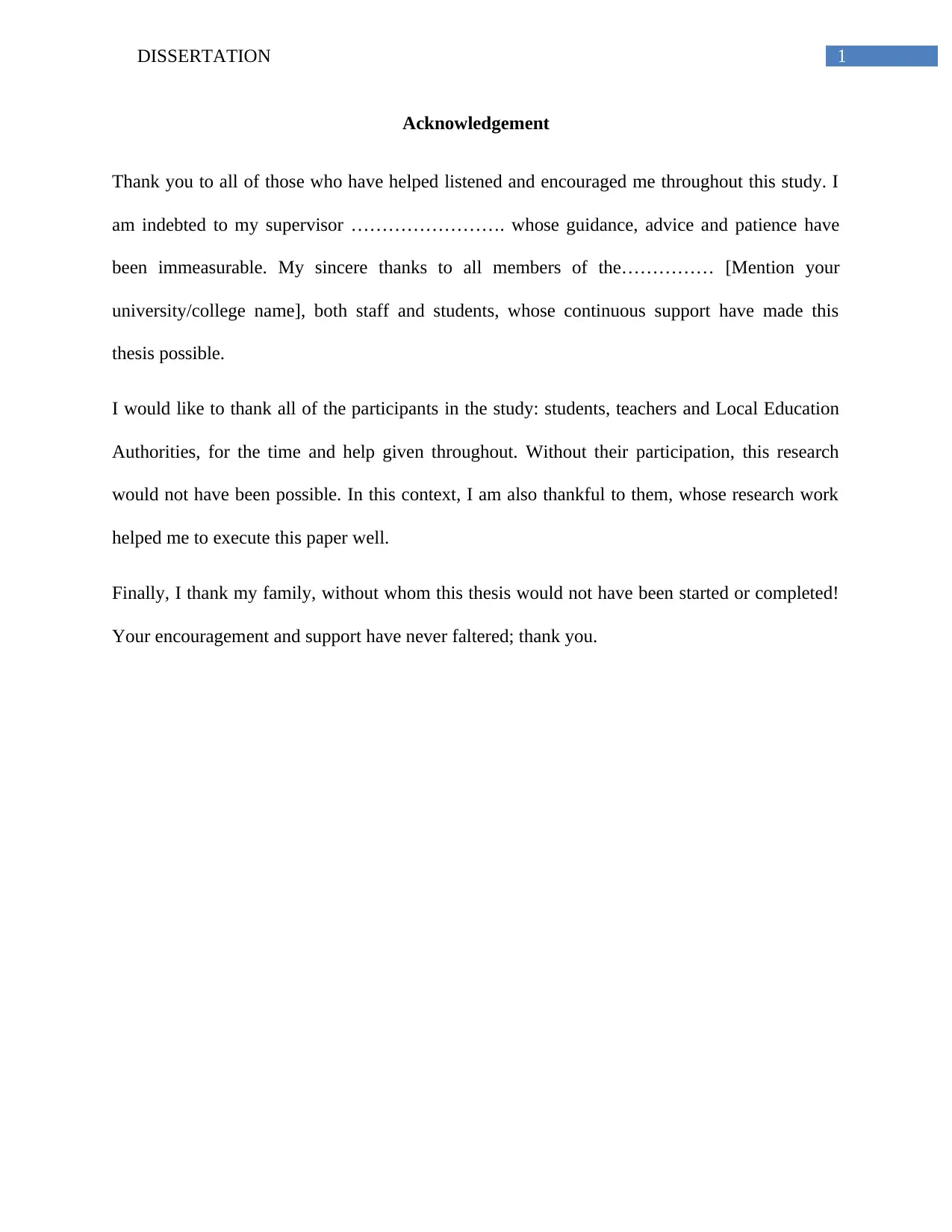
1DISSERTATION
Acknowledgement
Thank you to all of those who have helped listened and encouraged me throughout this study. I
am indebted to my supervisor ……………………. whose guidance, advice and patience have
been immeasurable. My sincere thanks to all members of the…………… [Mention your
university/college name], both staff and students, whose continuous support have made this
thesis possible.
I would like to thank all of the participants in the study: students, teachers and Local Education
Authorities, for the time and help given throughout. Without their participation, this research
would not have been possible. In this context, I am also thankful to them, whose research work
helped me to execute this paper well.
Finally, I thank my family, without whom this thesis would not have been started or completed!
Your encouragement and support have never faltered; thank you.
Acknowledgement
Thank you to all of those who have helped listened and encouraged me throughout this study. I
am indebted to my supervisor ……………………. whose guidance, advice and patience have
been immeasurable. My sincere thanks to all members of the…………… [Mention your
university/college name], both staff and students, whose continuous support have made this
thesis possible.
I would like to thank all of the participants in the study: students, teachers and Local Education
Authorities, for the time and help given throughout. Without their participation, this research
would not have been possible. In this context, I am also thankful to them, whose research work
helped me to execute this paper well.
Finally, I thank my family, without whom this thesis would not have been started or completed!
Your encouragement and support have never faltered; thank you.

2DISSERTATION
Abstract
The aim of the research is to study the impact of service quality on budget hotel operation in
hospitality and tourism industry that underlies the idea of enhancing the service quality standards
for ensuring customer satisfaction by eradicating the stereotypical expectation about budget
hotel.
The hospitality and tourism sector has seen a high rise over the past few years due to increased
demands of travelling for both career and leisure requirements. It has been seen that the
hospitality and the tourism sector contribute largely towards the economic growth of the country.
Some of the countries even rely solely on tourism and hospitality for their GDP. Service quality
determines the success of the hospitality industry, as this helps in understanding the expectation
and the perception.
Issues in terms of service quality are noticed in the operating procedures of budget hotels in
tourism and hospitality sector due to the existing gaps between expectation and perception. The
expectation and the perception of the customers and the employees differ largely due to the
distinctive personalities, needs, demands and requirements. The potential gaps in the service
quality include communication, empathy, assurance and being responsive.
Positivism philosophy, deductive approach, descriptive design and survey research strategy. As
survey research strategy has been selected, 50 people are selected for surveying by using simple
random probability sampling technique. The data has been collected by circulating online survey
questionnaire that contains 20-25 questions that is developed for studying service quality of
budget hotel operations in hospitality industry. This suggests primary data collection process
followed by quantitative data analysis technique that is presented using SPSS software.
Abstract
The aim of the research is to study the impact of service quality on budget hotel operation in
hospitality and tourism industry that underlies the idea of enhancing the service quality standards
for ensuring customer satisfaction by eradicating the stereotypical expectation about budget
hotel.
The hospitality and tourism sector has seen a high rise over the past few years due to increased
demands of travelling for both career and leisure requirements. It has been seen that the
hospitality and the tourism sector contribute largely towards the economic growth of the country.
Some of the countries even rely solely on tourism and hospitality for their GDP. Service quality
determines the success of the hospitality industry, as this helps in understanding the expectation
and the perception.
Issues in terms of service quality are noticed in the operating procedures of budget hotels in
tourism and hospitality sector due to the existing gaps between expectation and perception. The
expectation and the perception of the customers and the employees differ largely due to the
distinctive personalities, needs, demands and requirements. The potential gaps in the service
quality include communication, empathy, assurance and being responsive.
Positivism philosophy, deductive approach, descriptive design and survey research strategy. As
survey research strategy has been selected, 50 people are selected for surveying by using simple
random probability sampling technique. The data has been collected by circulating online survey
questionnaire that contains 20-25 questions that is developed for studying service quality of
budget hotel operations in hospitality industry. This suggests primary data collection process
followed by quantitative data analysis technique that is presented using SPSS software.
⊘ This is a preview!⊘
Do you want full access?
Subscribe today to unlock all pages.

Trusted by 1+ million students worldwide
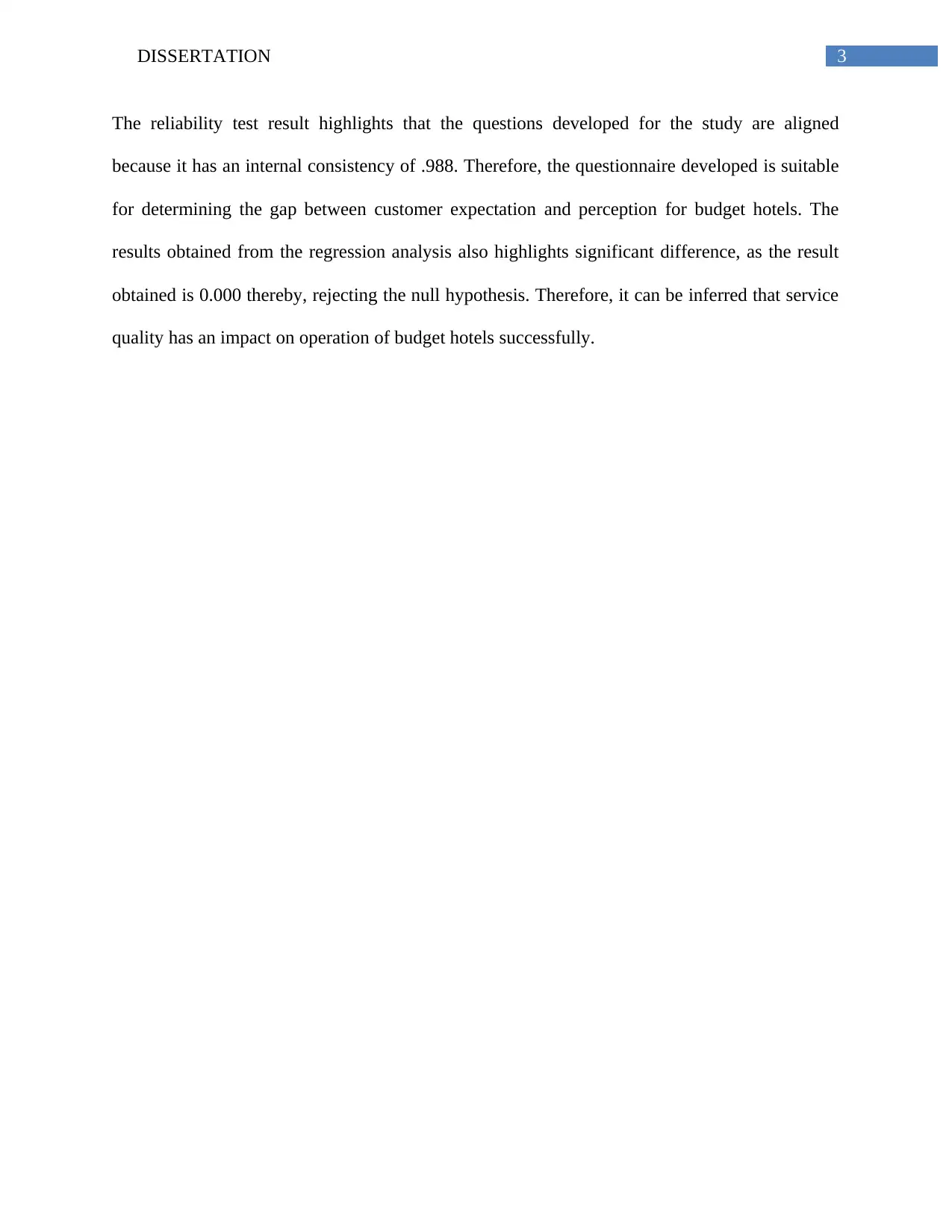
3DISSERTATION
The reliability test result highlights that the questions developed for the study are aligned
because it has an internal consistency of .988. Therefore, the questionnaire developed is suitable
for determining the gap between customer expectation and perception for budget hotels. The
results obtained from the regression analysis also highlights significant difference, as the result
obtained is 0.000 thereby, rejecting the null hypothesis. Therefore, it can be inferred that service
quality has an impact on operation of budget hotels successfully.
The reliability test result highlights that the questions developed for the study are aligned
because it has an internal consistency of .988. Therefore, the questionnaire developed is suitable
for determining the gap between customer expectation and perception for budget hotels. The
results obtained from the regression analysis also highlights significant difference, as the result
obtained is 0.000 thereby, rejecting the null hypothesis. Therefore, it can be inferred that service
quality has an impact on operation of budget hotels successfully.
Paraphrase This Document
Need a fresh take? Get an instant paraphrase of this document with our AI Paraphraser
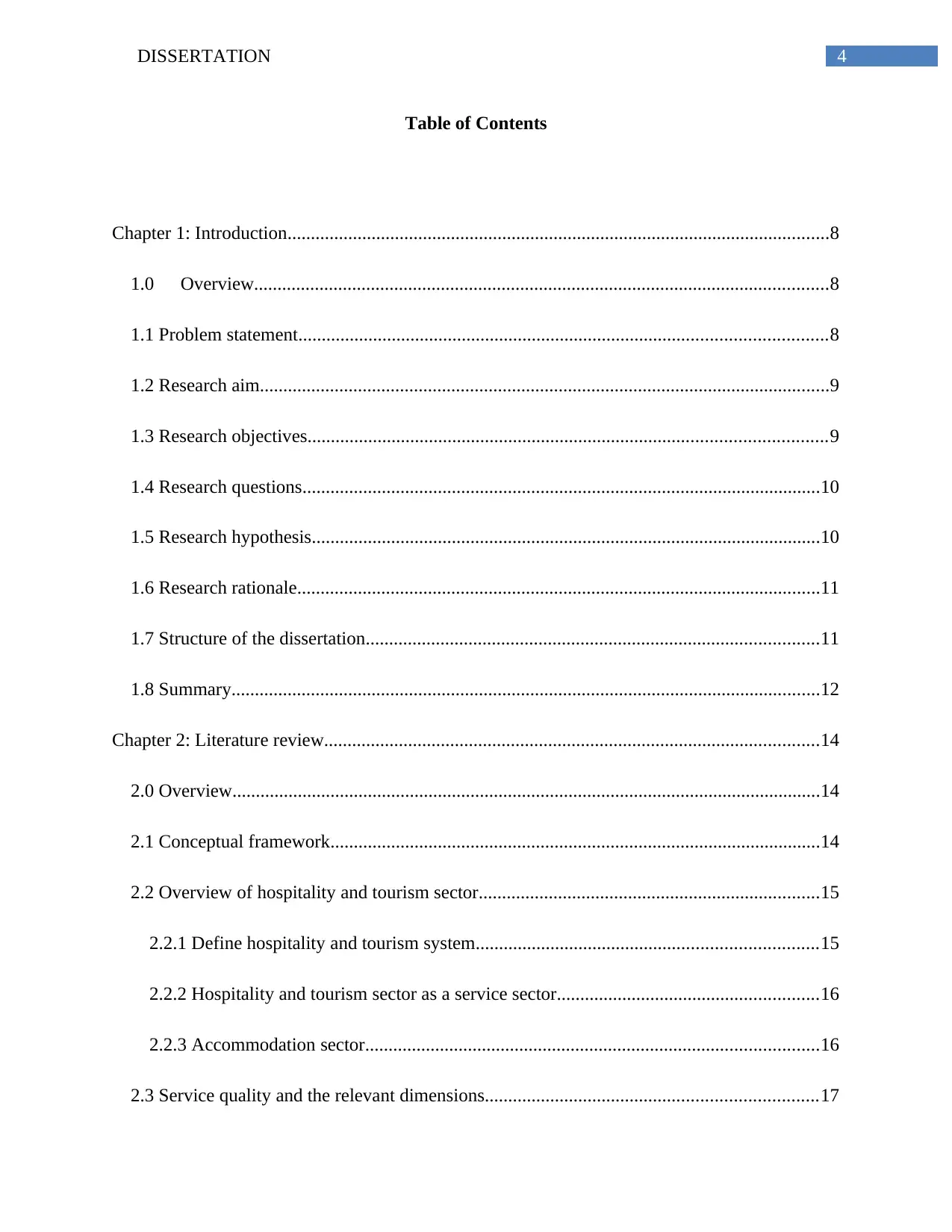
4DISSERTATION
Table of Contents
Chapter 1: Introduction....................................................................................................................8
1.0 Overview...........................................................................................................................8
1.1 Problem statement.................................................................................................................8
1.2 Research aim..........................................................................................................................9
1.3 Research objectives...............................................................................................................9
1.4 Research questions...............................................................................................................10
1.5 Research hypothesis.............................................................................................................10
1.6 Research rationale................................................................................................................11
1.7 Structure of the dissertation.................................................................................................11
1.8 Summary..............................................................................................................................12
Chapter 2: Literature review..........................................................................................................14
2.0 Overview..............................................................................................................................14
2.1 Conceptual framework.........................................................................................................14
2.2 Overview of hospitality and tourism sector.........................................................................15
2.2.1 Define hospitality and tourism system.........................................................................15
2.2.2 Hospitality and tourism sector as a service sector........................................................16
2.2.3 Accommodation sector.................................................................................................16
2.3 Service quality and the relevant dimensions.......................................................................17
Table of Contents
Chapter 1: Introduction....................................................................................................................8
1.0 Overview...........................................................................................................................8
1.1 Problem statement.................................................................................................................8
1.2 Research aim..........................................................................................................................9
1.3 Research objectives...............................................................................................................9
1.4 Research questions...............................................................................................................10
1.5 Research hypothesis.............................................................................................................10
1.6 Research rationale................................................................................................................11
1.7 Structure of the dissertation.................................................................................................11
1.8 Summary..............................................................................................................................12
Chapter 2: Literature review..........................................................................................................14
2.0 Overview..............................................................................................................................14
2.1 Conceptual framework.........................................................................................................14
2.2 Overview of hospitality and tourism sector.........................................................................15
2.2.1 Define hospitality and tourism system.........................................................................15
2.2.2 Hospitality and tourism sector as a service sector........................................................16
2.2.3 Accommodation sector.................................................................................................16
2.3 Service quality and the relevant dimensions.......................................................................17

5DISSERTATION
2.3.1 Concept of service quality............................................................................................17
2.3.2 Service nature...............................................................................................................17
2.3.3 Service characteristics..................................................................................................17
2.3.4 Dimensions of service quality......................................................................................18
2.4 Customers of a service organization....................................................................................20
2.4.1 SERVQUAL model..........................................................................................................20
2.4.2 Significance of internal customers (employees)...........................................................23
2.4.3 Understanding the difference between customer expectation and perception..............23
2.5 Service quality and budget hotel operation.........................................................................24
2.5.1 Relationship marketing theory......................................................................................24
2.5.2 Impact of service quality on customer retention of budget hotel operation.................25
2.5.3 Impact of service quality on customer loyalty of budget hotel operation....................25
2.5.4 Impact of service quality on budget hotel profitability................................................26
2.6 Summary..............................................................................................................................26
Chapter 3: Research methodology.................................................................................................28
3.0 Overview..............................................................................................................................28
3.1 Research outline...................................................................................................................28
3.2 Research philosophy............................................................................................................29
3.2.1 Explaining the use of positivism philosophy................................................................29
3.3 Research approach...............................................................................................................29
2.3.1 Concept of service quality............................................................................................17
2.3.2 Service nature...............................................................................................................17
2.3.3 Service characteristics..................................................................................................17
2.3.4 Dimensions of service quality......................................................................................18
2.4 Customers of a service organization....................................................................................20
2.4.1 SERVQUAL model..........................................................................................................20
2.4.2 Significance of internal customers (employees)...........................................................23
2.4.3 Understanding the difference between customer expectation and perception..............23
2.5 Service quality and budget hotel operation.........................................................................24
2.5.1 Relationship marketing theory......................................................................................24
2.5.2 Impact of service quality on customer retention of budget hotel operation.................25
2.5.3 Impact of service quality on customer loyalty of budget hotel operation....................25
2.5.4 Impact of service quality on budget hotel profitability................................................26
2.6 Summary..............................................................................................................................26
Chapter 3: Research methodology.................................................................................................28
3.0 Overview..............................................................................................................................28
3.1 Research outline...................................................................................................................28
3.2 Research philosophy............................................................................................................29
3.2.1 Explaining the use of positivism philosophy................................................................29
3.3 Research approach...............................................................................................................29
⊘ This is a preview!⊘
Do you want full access?
Subscribe today to unlock all pages.

Trusted by 1+ million students worldwide
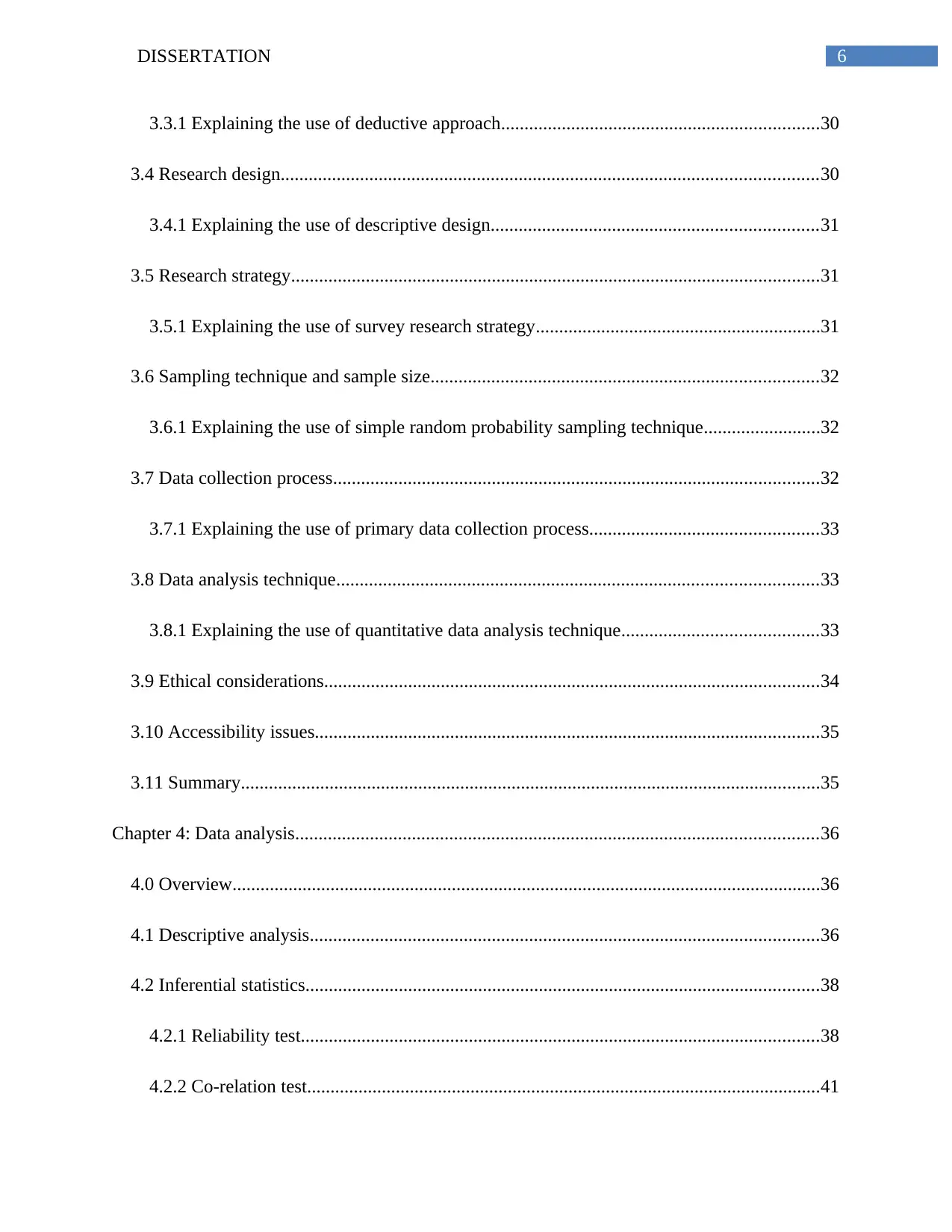
6DISSERTATION
3.3.1 Explaining the use of deductive approach....................................................................30
3.4 Research design...................................................................................................................30
3.4.1 Explaining the use of descriptive design......................................................................31
3.5 Research strategy.................................................................................................................31
3.5.1 Explaining the use of survey research strategy.............................................................31
3.6 Sampling technique and sample size...................................................................................32
3.6.1 Explaining the use of simple random probability sampling technique.........................32
3.7 Data collection process........................................................................................................32
3.7.1 Explaining the use of primary data collection process.................................................33
3.8 Data analysis technique.......................................................................................................33
3.8.1 Explaining the use of quantitative data analysis technique..........................................33
3.9 Ethical considerations..........................................................................................................34
3.10 Accessibility issues............................................................................................................35
3.11 Summary............................................................................................................................35
Chapter 4: Data analysis................................................................................................................36
4.0 Overview..............................................................................................................................36
4.1 Descriptive analysis.............................................................................................................36
4.2 Inferential statistics..............................................................................................................38
4.2.1 Reliability test...............................................................................................................38
4.2.2 Co-relation test..............................................................................................................41
3.3.1 Explaining the use of deductive approach....................................................................30
3.4 Research design...................................................................................................................30
3.4.1 Explaining the use of descriptive design......................................................................31
3.5 Research strategy.................................................................................................................31
3.5.1 Explaining the use of survey research strategy.............................................................31
3.6 Sampling technique and sample size...................................................................................32
3.6.1 Explaining the use of simple random probability sampling technique.........................32
3.7 Data collection process........................................................................................................32
3.7.1 Explaining the use of primary data collection process.................................................33
3.8 Data analysis technique.......................................................................................................33
3.8.1 Explaining the use of quantitative data analysis technique..........................................33
3.9 Ethical considerations..........................................................................................................34
3.10 Accessibility issues............................................................................................................35
3.11 Summary............................................................................................................................35
Chapter 4: Data analysis................................................................................................................36
4.0 Overview..............................................................................................................................36
4.1 Descriptive analysis.............................................................................................................36
4.2 Inferential statistics..............................................................................................................38
4.2.1 Reliability test...............................................................................................................38
4.2.2 Co-relation test..............................................................................................................41
Paraphrase This Document
Need a fresh take? Get an instant paraphrase of this document with our AI Paraphraser
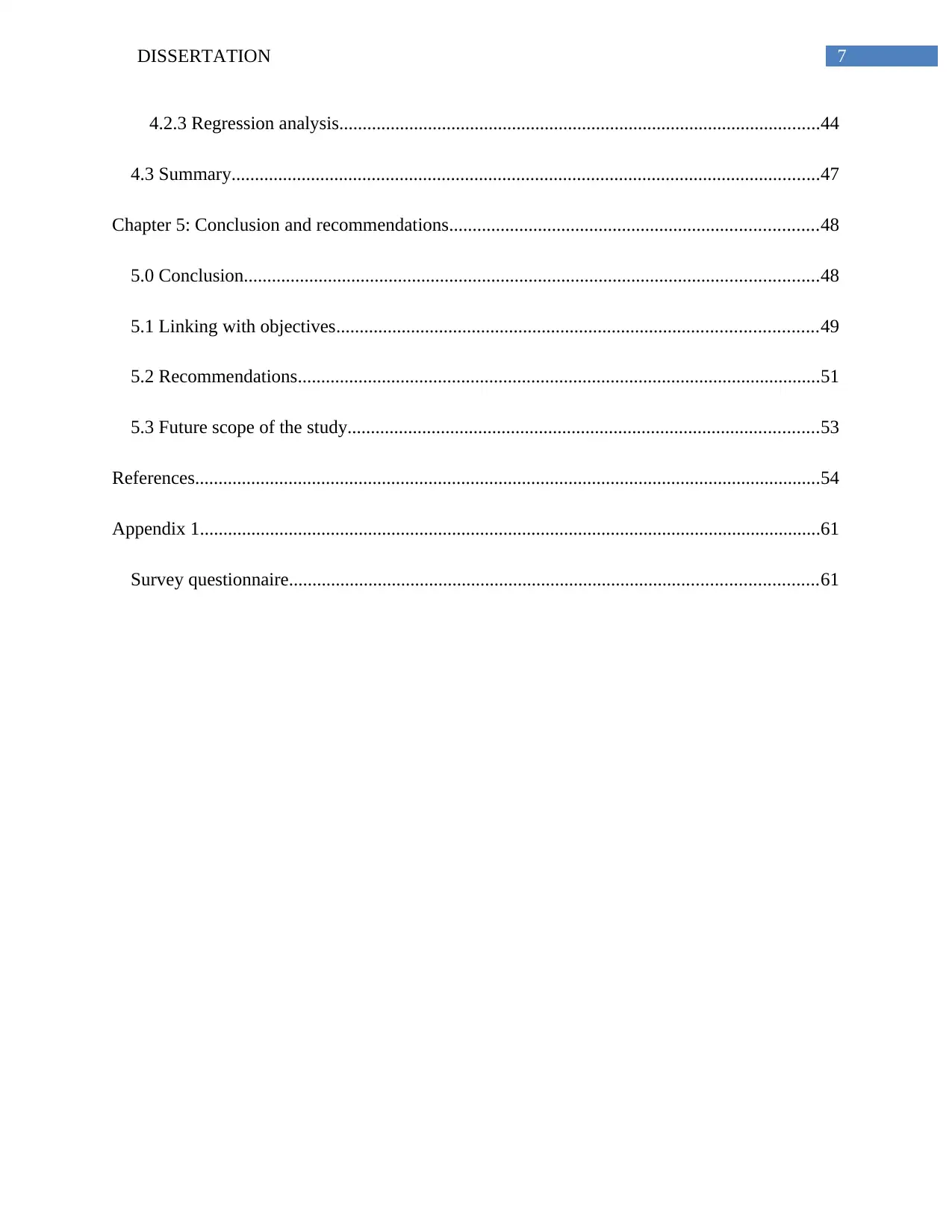
7DISSERTATION
4.2.3 Regression analysis.......................................................................................................44
4.3 Summary..............................................................................................................................47
Chapter 5: Conclusion and recommendations...............................................................................48
5.0 Conclusion...........................................................................................................................48
5.1 Linking with objectives.......................................................................................................49
5.2 Recommendations................................................................................................................51
5.3 Future scope of the study.....................................................................................................53
References......................................................................................................................................54
Appendix 1.....................................................................................................................................61
Survey questionnaire.................................................................................................................61
4.2.3 Regression analysis.......................................................................................................44
4.3 Summary..............................................................................................................................47
Chapter 5: Conclusion and recommendations...............................................................................48
5.0 Conclusion...........................................................................................................................48
5.1 Linking with objectives.......................................................................................................49
5.2 Recommendations................................................................................................................51
5.3 Future scope of the study.....................................................................................................53
References......................................................................................................................................54
Appendix 1.....................................................................................................................................61
Survey questionnaire.................................................................................................................61

8DISSERTATION
Chapter 1: Introduction
1.0 Overview
The hospitality and tourism sector has seen a high rise over the past few years due to
increased demands of travelling for both career and leisure requirements. It has been seen that
the hospitality and the tourism sector contribute largely towards the economic growth of the
country. Some of the countries even rely solely on tourism and hospitality for their GDP. Service
quality determines the success of the hospitality industry, as this helps in understanding the
expectation and the perception (Padilla-Melendez and Garrido-Moreno 2014). Understanding
and bridging the gap between the expectation and the perception helps in enhancing the quality
of the service, as this determines successful fulfillment of customer needs, desires, expectations
and requirements. The service quality is judged based on the SERVQUAL model that determines
the effectiveness of the quality of the service in budget hotels by analyzing five dimensions
namely, tangibles, responsiveness, assurance, empathy and reliability (Ali and Raza 2017).
The hospitality sector is growing at a faster pace with a broad outlook and budget hotels are
gaining popularity. The aim of the budget hotels is to serve the customers taking trips such as
backpacking and it is necessary to satisfy the needs of the customers by ensuring excellent
service quality (Dzhandzhugazova 2016).
1.1 Problem statement
Issues in terms of service quality are noticed in the operating procedures of budget hotels
in tourism and hospitality sector due to the existing gaps between expectation and perception.
The expectation and the perception of the customers and the employees differ largely due to the
distinctive personalities, needs, demands and requirements. The potential gaps in the service
Chapter 1: Introduction
1.0 Overview
The hospitality and tourism sector has seen a high rise over the past few years due to
increased demands of travelling for both career and leisure requirements. It has been seen that
the hospitality and the tourism sector contribute largely towards the economic growth of the
country. Some of the countries even rely solely on tourism and hospitality for their GDP. Service
quality determines the success of the hospitality industry, as this helps in understanding the
expectation and the perception (Padilla-Melendez and Garrido-Moreno 2014). Understanding
and bridging the gap between the expectation and the perception helps in enhancing the quality
of the service, as this determines successful fulfillment of customer needs, desires, expectations
and requirements. The service quality is judged based on the SERVQUAL model that determines
the effectiveness of the quality of the service in budget hotels by analyzing five dimensions
namely, tangibles, responsiveness, assurance, empathy and reliability (Ali and Raza 2017).
The hospitality sector is growing at a faster pace with a broad outlook and budget hotels are
gaining popularity. The aim of the budget hotels is to serve the customers taking trips such as
backpacking and it is necessary to satisfy the needs of the customers by ensuring excellent
service quality (Dzhandzhugazova 2016).
1.1 Problem statement
Issues in terms of service quality are noticed in the operating procedures of budget hotels
in tourism and hospitality sector due to the existing gaps between expectation and perception.
The expectation and the perception of the customers and the employees differ largely due to the
distinctive personalities, needs, demands and requirements. The potential gaps in the service
⊘ This is a preview!⊘
Do you want full access?
Subscribe today to unlock all pages.

Trusted by 1+ million students worldwide

9DISSERTATION
quality include communication, empathy, assurance and being responsive (Peprah and Atarah
2014). Often in the hospitality and the tourism industry, the difference between the expectation
and the perception tend to broaden, as lack of understanding arises. The gaps in the service
quality results in customer dissatisfaction and decreases the popularity of the budget hotels.
Additionally, failures to understand the expectation of the leads to operational issues in the
budget hotels, as the hotels are unable to fulfill the needs and expectations of the customers
(Yarimoglu 2014).
1.2 Research aim
The aim of the research is to study the impact of service quality on budget hotel operation
in hospitality and tourism industry that underlies the idea of enhancing the service quality
standards for ensuring customer satisfaction by eradicating the stereotypical expectation about
budget hotel.
The study links the standard of service quality with the overall feedback of the customers
about the quality of service on budget hotel thereby, ensuring improvement of the service
quality. As a result, more knowledge and ideas can be provided for enhancing the service quality.
Additionally, in future the information can be used for enhancing service quality in the
hospitality and tourism industry.
1.3 Research objectives
The questions of the research are:
To identify general service quality on budget hotels.
To identify feedbacks from customers on how they experienced service quality in budget
hotels.
quality include communication, empathy, assurance and being responsive (Peprah and Atarah
2014). Often in the hospitality and the tourism industry, the difference between the expectation
and the perception tend to broaden, as lack of understanding arises. The gaps in the service
quality results in customer dissatisfaction and decreases the popularity of the budget hotels.
Additionally, failures to understand the expectation of the leads to operational issues in the
budget hotels, as the hotels are unable to fulfill the needs and expectations of the customers
(Yarimoglu 2014).
1.2 Research aim
The aim of the research is to study the impact of service quality on budget hotel operation
in hospitality and tourism industry that underlies the idea of enhancing the service quality
standards for ensuring customer satisfaction by eradicating the stereotypical expectation about
budget hotel.
The study links the standard of service quality with the overall feedback of the customers
about the quality of service on budget hotel thereby, ensuring improvement of the service
quality. As a result, more knowledge and ideas can be provided for enhancing the service quality.
Additionally, in future the information can be used for enhancing service quality in the
hospitality and tourism industry.
1.3 Research objectives
The questions of the research are:
To identify general service quality on budget hotels.
To identify feedbacks from customers on how they experienced service quality in budget
hotels.
Paraphrase This Document
Need a fresh take? Get an instant paraphrase of this document with our AI Paraphraser
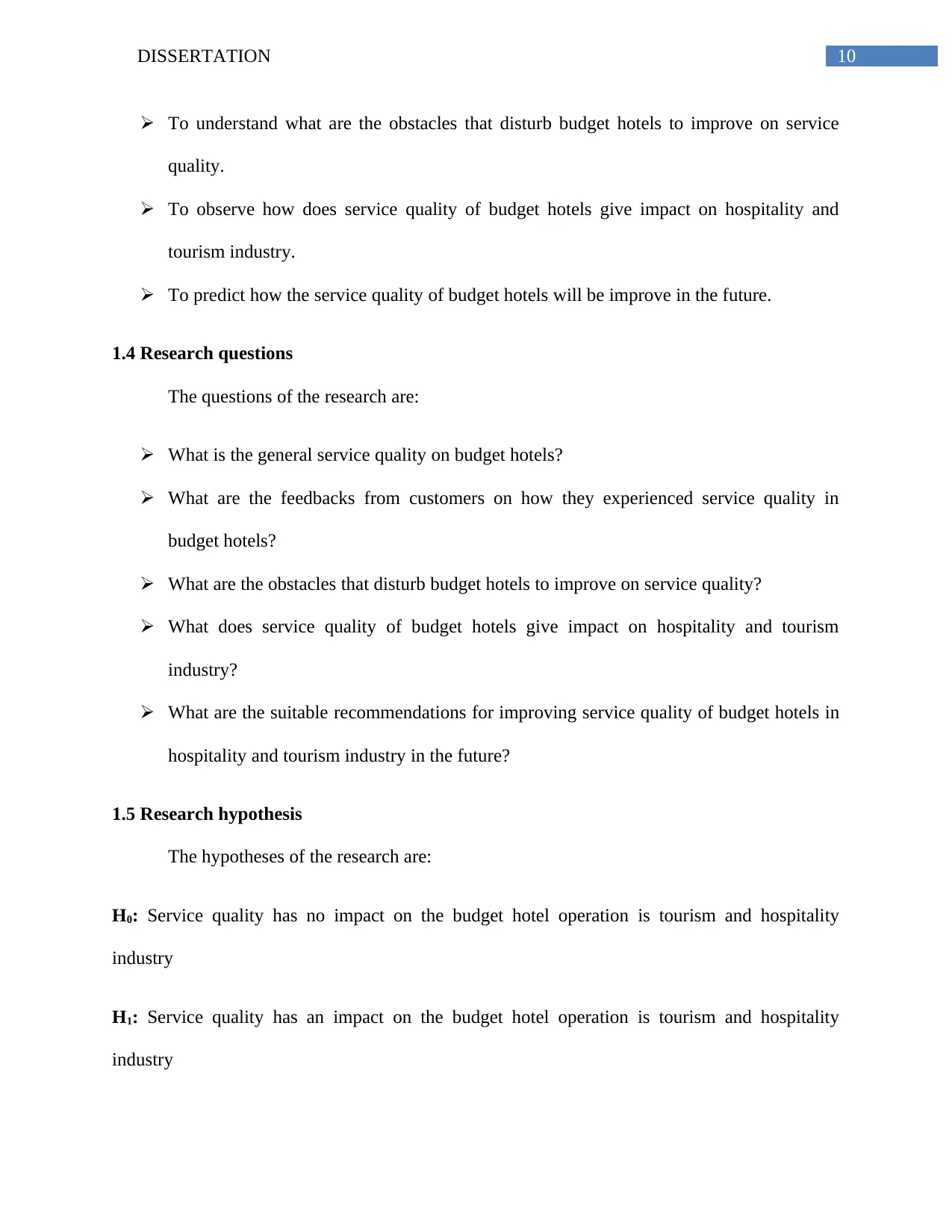
10DISSERTATION
To understand what are the obstacles that disturb budget hotels to improve on service
quality.
To observe how does service quality of budget hotels give impact on hospitality and
tourism industry.
To predict how the service quality of budget hotels will be improve in the future.
1.4 Research questions
The questions of the research are:
What is the general service quality on budget hotels?
What are the feedbacks from customers on how they experienced service quality in
budget hotels?
What are the obstacles that disturb budget hotels to improve on service quality?
What does service quality of budget hotels give impact on hospitality and tourism
industry?
What are the suitable recommendations for improving service quality of budget hotels in
hospitality and tourism industry in the future?
1.5 Research hypothesis
The hypotheses of the research are:
H0: Service quality has no impact on the budget hotel operation is tourism and hospitality
industry
H1: Service quality has an impact on the budget hotel operation is tourism and hospitality
industry
To understand what are the obstacles that disturb budget hotels to improve on service
quality.
To observe how does service quality of budget hotels give impact on hospitality and
tourism industry.
To predict how the service quality of budget hotels will be improve in the future.
1.4 Research questions
The questions of the research are:
What is the general service quality on budget hotels?
What are the feedbacks from customers on how they experienced service quality in
budget hotels?
What are the obstacles that disturb budget hotels to improve on service quality?
What does service quality of budget hotels give impact on hospitality and tourism
industry?
What are the suitable recommendations for improving service quality of budget hotels in
hospitality and tourism industry in the future?
1.5 Research hypothesis
The hypotheses of the research are:
H0: Service quality has no impact on the budget hotel operation is tourism and hospitality
industry
H1: Service quality has an impact on the budget hotel operation is tourism and hospitality
industry
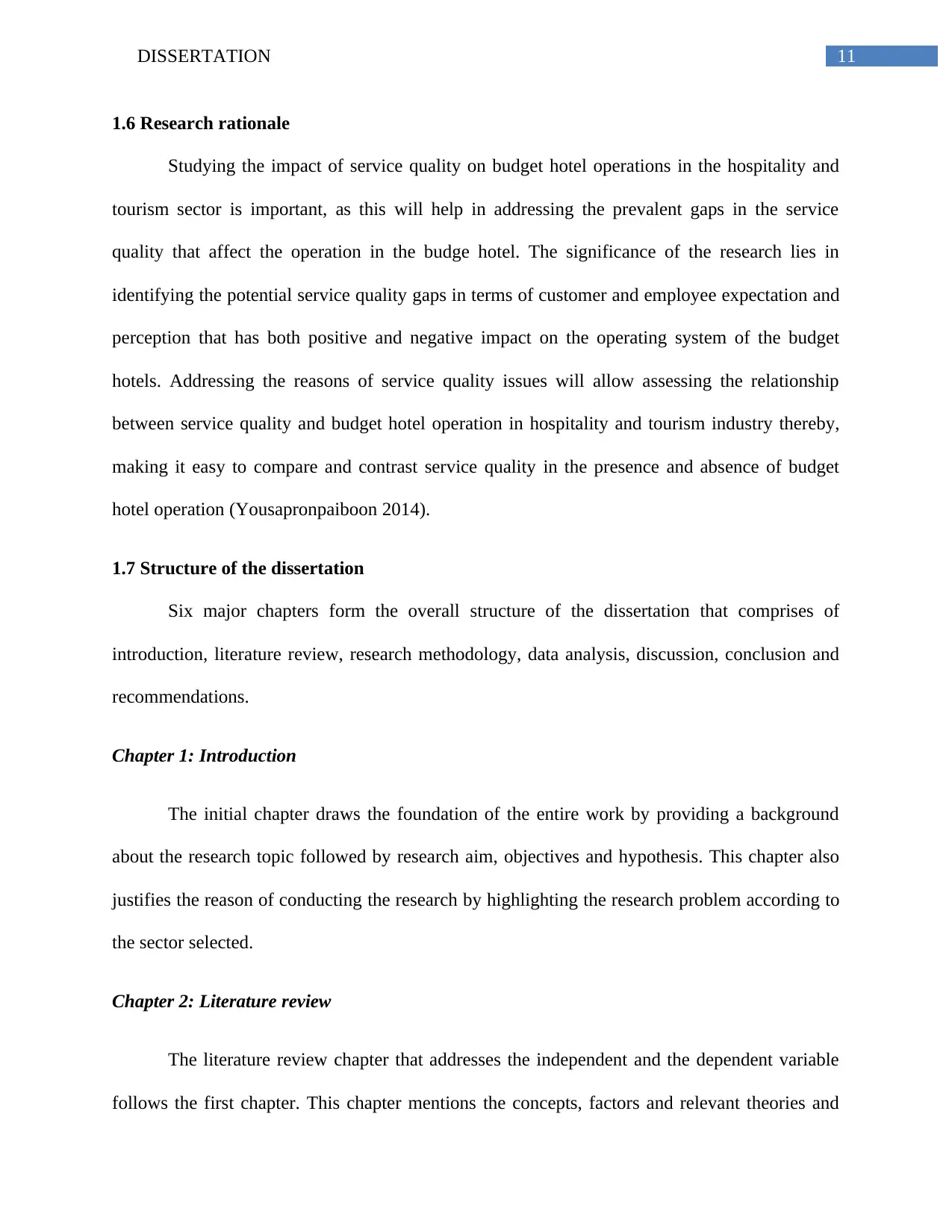
11DISSERTATION
1.6 Research rationale
Studying the impact of service quality on budget hotel operations in the hospitality and
tourism sector is important, as this will help in addressing the prevalent gaps in the service
quality that affect the operation in the budge hotel. The significance of the research lies in
identifying the potential service quality gaps in terms of customer and employee expectation and
perception that has both positive and negative impact on the operating system of the budget
hotels. Addressing the reasons of service quality issues will allow assessing the relationship
between service quality and budget hotel operation in hospitality and tourism industry thereby,
making it easy to compare and contrast service quality in the presence and absence of budget
hotel operation (Yousapronpaiboon 2014).
1.7 Structure of the dissertation
Six major chapters form the overall structure of the dissertation that comprises of
introduction, literature review, research methodology, data analysis, discussion, conclusion and
recommendations.
Chapter 1: Introduction
The initial chapter draws the foundation of the entire work by providing a background
about the research topic followed by research aim, objectives and hypothesis. This chapter also
justifies the reason of conducting the research by highlighting the research problem according to
the sector selected.
Chapter 2: Literature review
The literature review chapter that addresses the independent and the dependent variable
follows the first chapter. This chapter mentions the concepts, factors and relevant theories and
1.6 Research rationale
Studying the impact of service quality on budget hotel operations in the hospitality and
tourism sector is important, as this will help in addressing the prevalent gaps in the service
quality that affect the operation in the budge hotel. The significance of the research lies in
identifying the potential service quality gaps in terms of customer and employee expectation and
perception that has both positive and negative impact on the operating system of the budget
hotels. Addressing the reasons of service quality issues will allow assessing the relationship
between service quality and budget hotel operation in hospitality and tourism industry thereby,
making it easy to compare and contrast service quality in the presence and absence of budget
hotel operation (Yousapronpaiboon 2014).
1.7 Structure of the dissertation
Six major chapters form the overall structure of the dissertation that comprises of
introduction, literature review, research methodology, data analysis, discussion, conclusion and
recommendations.
Chapter 1: Introduction
The initial chapter draws the foundation of the entire work by providing a background
about the research topic followed by research aim, objectives and hypothesis. This chapter also
justifies the reason of conducting the research by highlighting the research problem according to
the sector selected.
Chapter 2: Literature review
The literature review chapter that addresses the independent and the dependent variable
follows the first chapter. This chapter mentions the concepts, factors and relevant theories and
⊘ This is a preview!⊘
Do you want full access?
Subscribe today to unlock all pages.

Trusted by 1+ million students worldwide
1 out of 63
Related Documents
Your All-in-One AI-Powered Toolkit for Academic Success.
+13062052269
info@desklib.com
Available 24*7 on WhatsApp / Email
![[object Object]](/_next/static/media/star-bottom.7253800d.svg)
Unlock your academic potential
Copyright © 2020–2025 A2Z Services. All Rights Reserved. Developed and managed by ZUCOL.




